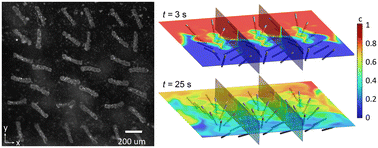Mixing in stagnant microfluidic environments is essential for many applications but is inherently challenging to achieve, due to the difficulty in generating effective flow disturbances at the sub-millimetre scale. Traditional passive micromixers require externally driven flow to work, while active mixers often have restrictive use cases with undesirable side-effects. In this study, we designed a 6 × 6 array of multi-directionally inclined magnetic artificial cilia that can be manufactured using a newly developed micromolding process. The array can generate strong local mixing by creating overlapping vortical flows generated by the cilia's tilted conical motion, as well as efficient global mixing by producing a complex flow pattern composed of a collection of predesigned, criss-crossing net flow vectors. Experimental results show effective mixing in stagnant microfluidic environments within 25 seconds when the cilia are actuated by a rotating global magnetic field at a frequency of 20 Hz. We performed fully coupled simulations to design the 3D motion of the cilia. Simulations of double-cilia systems with prescribed motion provide insights for designing the large array, and a simulation of the full array was performed to analyse the mixing effect in 3D.
